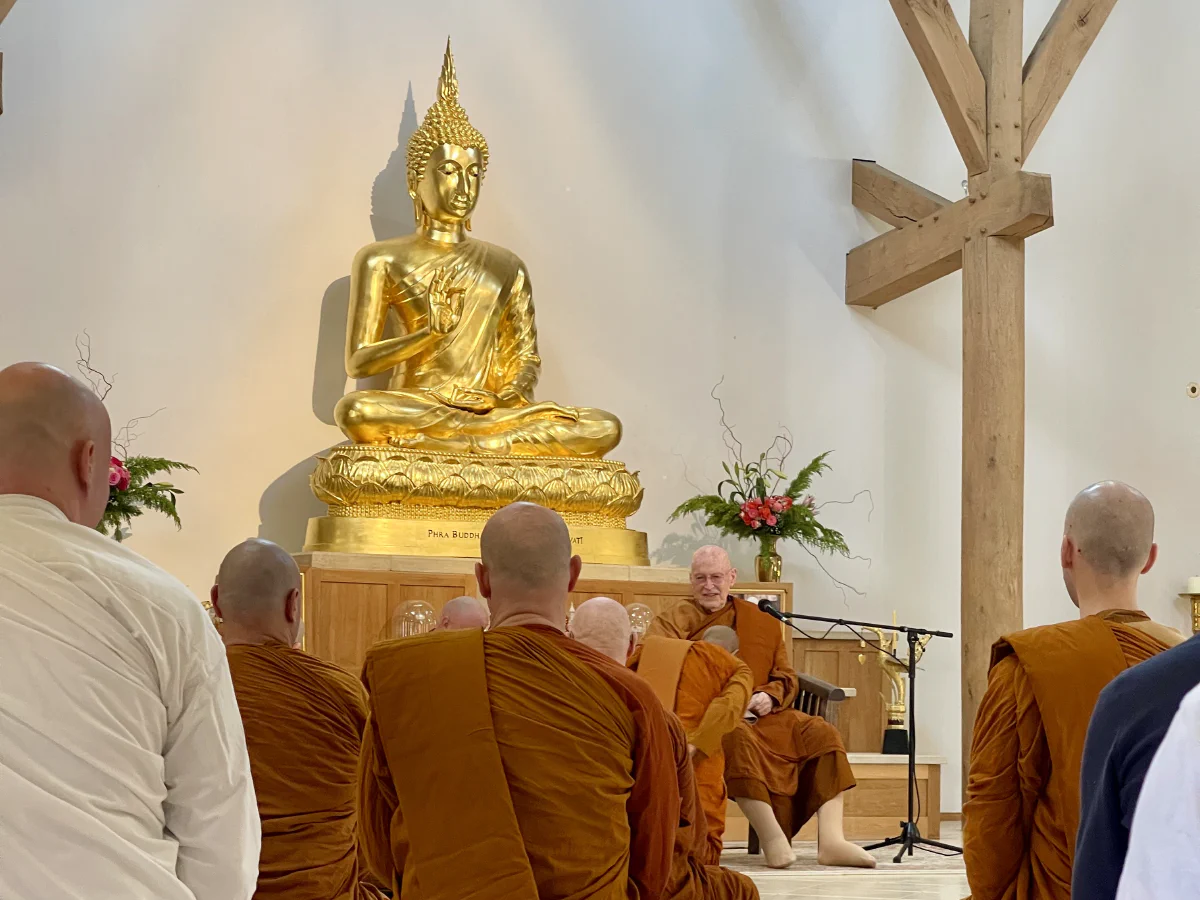My Path to Buddhism

A few folks have asked how I started practicing Therevada Buddhism. Here’s the story.
Early exposure: Om towels, Richard Hittleman, and public radio
My parents practiced yoga and meditation when I was young. They had towels with hand-embroidered “Om” symbols on them that they used as yoga mats. What can I say – they were hippies. And I’m so grateful.
One day I discovered Richard Hittleman’s Guide to Yoga Meditation among my parents’ books. A relic of the 60s, it was totally “groovy”, weird and wonderful. I loved his idea of the “universal mind” which I now think of as Dhamma. I devoured it and started trying to practice as best I could. I still have this book in my personal library, repaired multiple times with packing tape.
In my teens, I discovered the Upanishads, the Tao Te Ching, and Siddhartha. I became peripherally aware of Tibetan Buddhism and one evening I heard a talk on our local community radio station from a guy with an unusual accent about compassion and the importance of developing a rich interior life. Later I learned it was the 14th Dalai Lama. I was transfixed but struggled to really understand the message. I also knew a few people in highschool who were into the Free Tibet movement but seemed to me more interested in wearing patchouli and fondling mala beads [Full disclosure: I now have some mala beads in my sock drawer. 😆 ]
“Oh well”, I thought. “Too bad I wasn’t born in Tibet.”
I was definitely curious but it felt a bit like cultural appropriation and somehow just out of reach: nice to look at but too esoteric and too difficult to apply to my own life growing up in St. Louis MO, USA.
I thought “Oh well, too bad I wasn’t born in Tibet”. Today I realise how lazy and small-minded that line of thinking was. Ah, youth…
Harmonic Resonance & Halloween
I didn’t think much more about Buddhism as a thing that I could do until May of 2019 when I went on an amazing retreat hosted by musician David Hykes at his home in rural France. Between our group finding the resonant frequencies in our voices, he mentioned to the group about how much Buddhism had impacted his life. At the end of the trip he told me “Buddhism is a wonderful path”.
This piqued my interest again.
In autumn of that year I was at a Halloween party talking about volunteer work. A fellow party-goer mentioned that he sometimes traveled out to Hertfordshire to cook rice for the monks at Amaravati, a Therevada Buddhist monastery not far from London.
“A Buddhist monastery in England?…Impossible!” 🤦
I was dumbfounded in my ignorance: “What’s this? A Buddhist monastery in England? Just outside London? Impossible!” 🤦 Clearly I hadn’t learned much since highschool.
I discovered that Amaravati offered weekend meditation classes and thought, why not? So off I went to try it for myself.
After a short bike, then train, then taxi ride, I was standing at the gates. Not quite the scene from a Marvel movie, I was greeted by a set of low brown buildings.
I followed a group of people into a small annex as the main temple was being used for another event. I removed my shoes and went inside where a young monk led us through 20 minutes of guided meditation, 20 minutes of walking meditation, 20 more minutes of seated meditation, some Q&A, and a lovely little Dhamma talk on the power of “good enough”. It was inspired by the group of post-graduate students visiting that day from Goodenough College and it really scratched an itch.
On my way out, I picked up “Peace is a Simple Step” by Ajahn Sumedho and started reading it.
I couldn’t believe how lucid and clear the language was and how easily I could imagine applying the teachings to my own life.
Flipping back to the introduction, I learned that Ajahn Sumedho was born “Robert Jackman” in Seattle WA – my hometown! He served in the Korean War as a medic in the US Navy, then studied Far Eastern studies at Berkley, became a Red Cross social worker and finally joined the Peace Corps.
One day, while on a break in Singapore, he was sitting at a cafe where he saw a Buddhist monk walk by and thought “that looks interesting”. He ordained under Ajahn Chah in 1966.
Inspired, I began reading as many books and listening to as many Dhamma talks from Amaravati as I could.
Discovering Amaravati and this gentle, practical form of Buddhism at the end of 2019 was perfect timing. When Covid hit and the world shut down, we all suddenly had a lot of time to contemplate and cultivate our interior worlds, developing more balanced and integrative relationships with reality. Meditation became part of my daily routine and I’ve tried to keep it up consistently ever since.
“We don’t need much to practice; only this body and this mind.” – Ajahn Chah
What attracted me to the style of Ajahn Chah’s teachings and those of his students is their simple directness. He was once quoted as saying “We don’t need much to practice, only this body and this mind.”
It’s a wonderfully deep practice but you can start as simply as you like and still get tremendous benefits. For example, just thinking about the five precepts can open a wonderful path of enquiry and practice.
Just thinking about the five precepts can open a wonderful path of enquiry.
The five precepts
Do your best to refrain from:
- killing
- lying
- stealing
- committing sexual misconduct
- intoxicating yourself
Far from “commandments” backed by threats, the precepts are simply “guidelines” underpinned by a gentle invitation to investigate the deepest truest nature of reality and our own experience of it. Observe what happens when you follow the precepts, or when you don’t. As you take on the role of “witness” to your own experience, you don’t get as tangled up in desire, confusion, anxiety, etc but can learn to see things clearly. As Luang Por Sumedho once said in a Dhamma talk, “That which is aware of grumpiness isn’t grumpy.”
It fits nicely with my work on OKRs as a way for teams and organisations to better understand and work with reality, rather than the fantasies we typically hang onto.
If you’re curious, do check out Peace is a Simple Step or watch a few Dhamma talks. Or simply try out the 5 precepts for yourself and see what happens!
Check out my personal notes on Buddhist teachings that I’ve found helpful.

